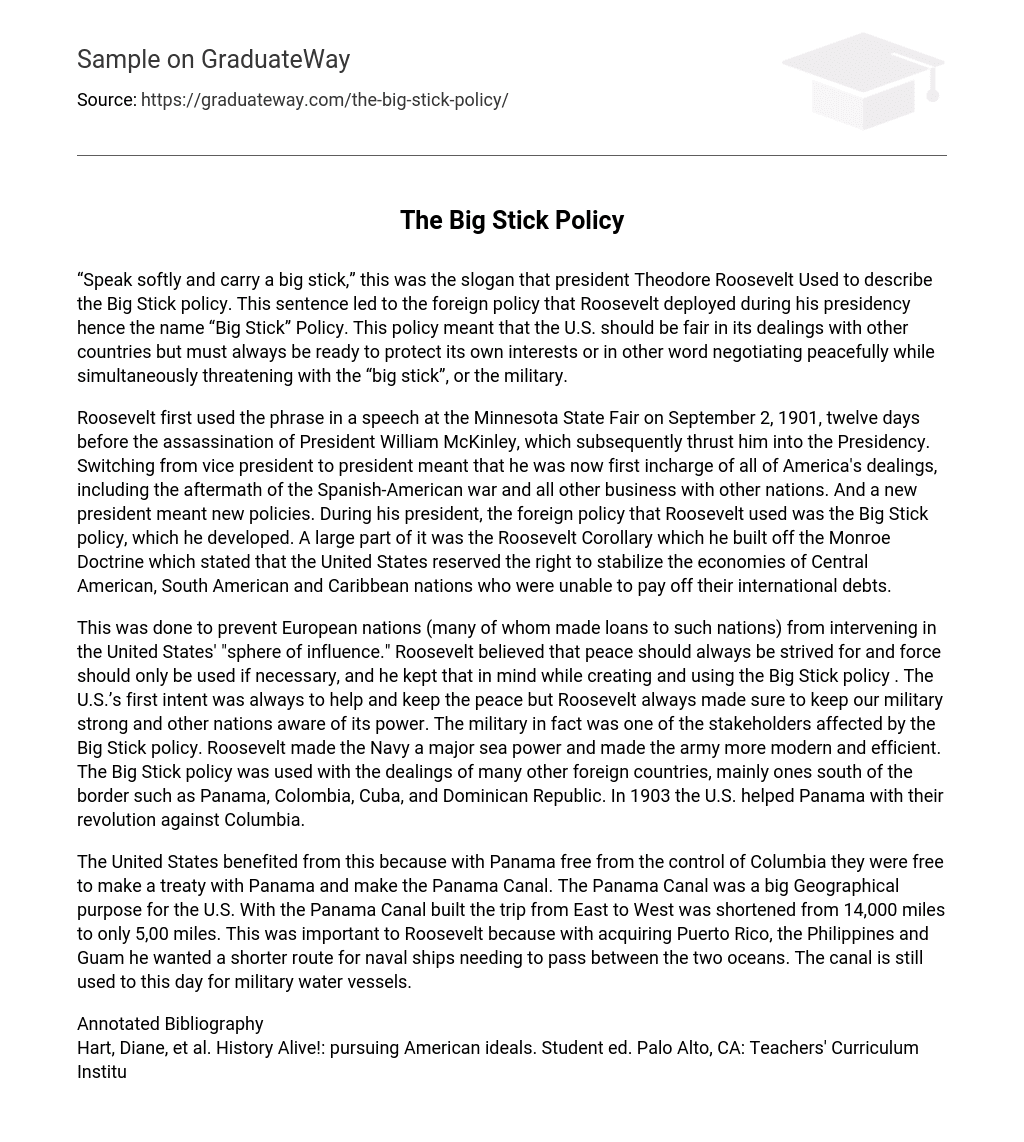President Theodore Roosevelt implemented the Big Stick policy during his presidency. The policy was represented by the slogan “Speak softly and carry a big stick.” It aimed to prioritize both diplomatic negotiations and military readiness in order to protect American interests when required.
Roosevelt introduced the phrase during a speech at the Minnesota State Fair on September 2, 1901, just twelve days prior to assuming the presidency following President McKinley’s assassination. As president, Roosevelt assumed responsibility for all American affairs, including those resulting from the Spanish-American war and diplomatic relations with other countries. Throughout his presidency, he implemented a new foreign policy known as the Big Stick policy, which involved the development of the Roosevelt Corollary. The Roosevelt Corollary expanded upon the Monroe Doctrine and authorized the United States to intervene in Central American, South American, and Caribbean nations’ economies if they were unable to repay their international debts.
The purpose of this action was to prevent European nations, many of which had provided loans to these nations, from intervening in the “sphere of influence” of the United States. President Roosevelt believed in the importance of striving for peace and using force only when necessary. He kept this in mind when developing and implementing the Big Stick policy. The initial intention of the United States was always to aid and maintain peace, but Roosevelt also ensured that our military remained strong and that other nations were aware of its power. The military was one of the stakeholders impacted by the Big Stick policy. Roosevelt bolstered the Navy’s status as a major sea power and modernized and improved the efficiency of the army. The Big Stick policy extended to dealings with various foreign countries, particularly those in Latin America such as Panama, Colombia, Cuba, and the Dominican Republic. In 1903, the United States assisted Panama in their revolution against Colombia.
When Panama gained independence from Colombia, the United States saw an opportunity to negotiate and build the Panama Canal. The construction of this canal was highly significant for the US because it reduced the travel distance between the East and West coasts from 14,000 miles to only 5,000 miles. This was especially important for President Roosevelt as he had recently acquired Puerto Rico, the Philippines, and Guam and wanted a more efficient route for naval ships to move between the Atlantic and Pacific Oceans. Currently, military watercraft still make use of the canal.
Annotated Bibliography
Hart, Diane, et al. (2008). History Alive!: pursuing American ideals. Student ed. Palo Alto, CA: Teachers’ Curriculum Institute. Print.
This source is a high school U.S. history textbook for 11th grade students that provides information on the basics of the Big Stick policy, including its creators and timeline. The reliability of this textbook can be trusted as it was created for national use by students and teachers and is written from an American perspective by Diana Hart and other scholars.
Roosevelt Theodore.
Britannica Elementary Encyclopedia. (2003). eLibrary. Web. 13 Nov 2013.
“The Big Stick” is an online History textbook that offers accurate and useful information about American history. It specifically provides valuable insights about the Big Stick policy, including the reasons behind its creation and the foreign countries it was implemented in. This online textbook is trustworthy due to its numerous sources and helpful attachments, such as a study guide, practice quiz, and digital flashcards. Furthermore, its reliability is evident through the consistency of information it provides when compared to other reliable sources. Originally designed as an online textbook for students and educators, “The Big Stick” is a reliable source of knowledge. Another relevant source, “Theodore Roosevelt’s Corollary to the Monroe Doctrine,” can be found in eLibrary.
This website serves as an online representation of the Roosevelt Corollary, which was written by President Roosevelt. Through this website, I gained a comprehensive understanding of the intricacies of the corollary to the Monroe Doctrine and its overall policy. The Roosevelt Corollary addresses various aspects including foreign policy, arbitration treaties, and policies towards other countries in the western hemisphere.





